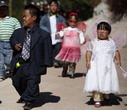Domestic
Sanyuan to employ all staff of scandal-hit Sanlu
(Xinhua)
Updated: 2009-05-02 22:11
All staff of Sanlu Group, the bankrupt dairy company at the center of the melamine contamination scandal, will be reemployed by November, the company's new owner said Thursday.
So far, Hebei Sanyuan Foods Co Ltd, a subsidiary of the Beijing Sanyuan Foods Co Ltd that bought Sanlu Group in an auction in March, has signed contracts with 2,594 former employees of Sanlu, said Gao Qingshan, board chairman of the subsidiary firm.
| ||||
As of the end of 2008, Sanlu had 4,332 registered active-duty staff, 455 retirees and three employees with industrial injuries.
Gao said the new company's current production capacity was about 60 percent of that of Sanlu and the revenue is expected to reach 1.2 billion yuan ($176 million) this year.
The revenue is expected to catch up with Sanlu's best level in three years, when the new company will become a leading dairy firm among other domestic competitors, said Gao.
Sanlu has promised to recruit all Sanlu's staff when it won the bid of the scandal-hit dairy group's assets, in response to the call of the Shijiazhuang municipal government to guarantee worker's interests.
Sanlu had been China's leading seller of milk powder for 15 years until the melamine scandal broke in September last year. The group's revenue hit 10 billion yuan in 2007, while Sanyuan's revenue was 1 billion yuan.
Sanlu stopped production on Sept 12 after its melamine-tainted baby milk powder was found to have caused the deaths of at least six children and sickened some 300,000 children.













